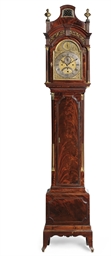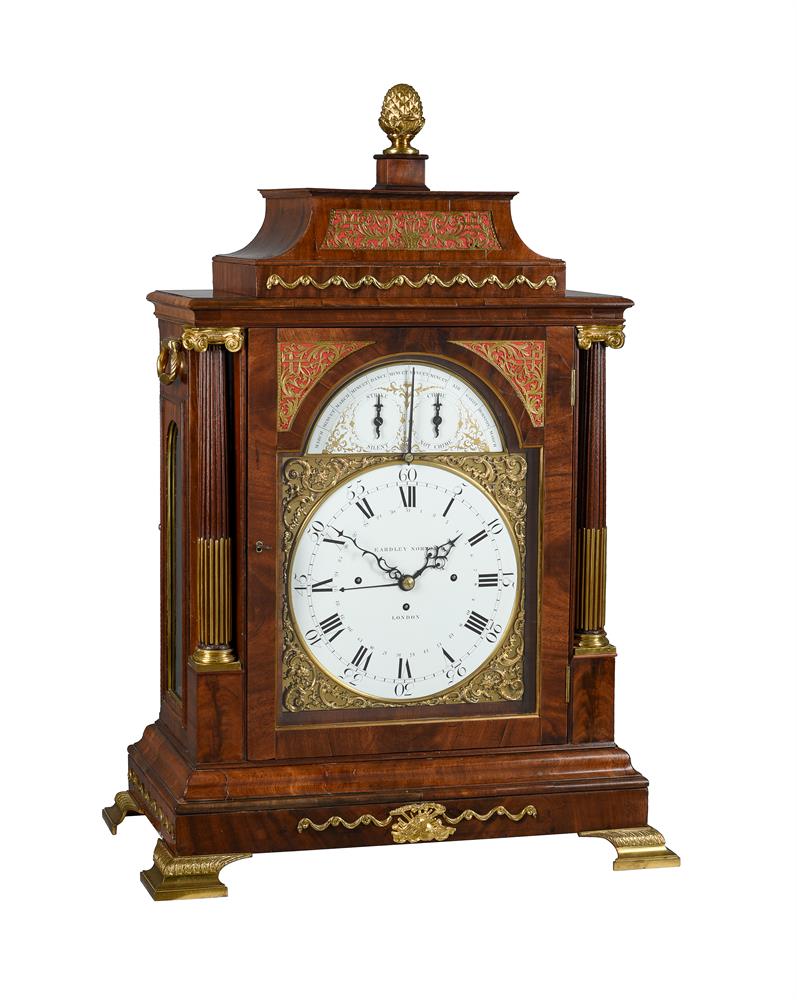A George III gilt brass mounted musical table clock Merlin, London, circa 1765-75 The substantial six pillar triple fusee movement with verge escapement regulated by short bob pendulum and playing a choice of two tunes on a graduated nest of eight bells with sixteen hammers every hour prior to sounding the hour on a further larger bell, the backplate finely engraved with asymmetric foliate scrolls and with external fly for the music train, the 8 inch brass break-arch dial applied with circular convex white enamel disc signed MERLIN, LONDON to centre within Roman hour chapters and Arabic five minutes beyond the minute ring, with scroll-pierced steel hands, moulded brass bezel surround and fine chased leafy scroll cast spandrels to angles, the arch with central conforming enamel calendar dial flanked by further SONNE/NON SONNE and MENUET/ALLEMANDE selection dials within conforming applied foliate pierced and chased infill, the bell-top case with hinged brass carrying handle and top plate to the gilt fillet-bordered superstructure flanked by pineapple finials over twin cavetto top mouldings and brass fillet inset glazed dial aperture to the front door incorporating fine engraved foliate scroll pierced brass quadrant frets to upper angles, flanked by canted angles applied with gilt female terms over floral trails, the sides with brass fillet-bordered circular over concave-topped scroll-pieced sound frets, the rear matching the front including fine engraved frets to the upper quadrants, on cavetto moulded skirt base faced in brass over ogee bracket feet, 52cm (20.5ins) high excluding handle. John Joseph Merlin was born in Huys, near Maastricht, Belgium in 1753. It is believed that he was of Huguenot extraction and his family were probably mechanically minded. Very little is known regarding Merlin's apprenticeships or training prior to his arrival in Paris in around 1754 (possibly under the encouragement of Academie des Sciences) where he made his mark in mechanical circles before travelling to London (within the entourage of the Comte de Fuentes, the Spanish Ambassador Extraordinary) In 1760. Such was Merlin's skill that by 1763 he was noted as being involved in the finishing of a large barrel organ for the Prince of Wales at Carlton House and subsequently became involved with James Cox during the lead-up to the creation of Cox's Museum in Spring Gardens in 1772/3. In 1773 Merlin is noted as working from 42 Queen Anne Street East and filed a patent for a Dutch Oven; with another submitted the following year for a compound-harpsichord. He worked principally as a 'mechanic', and maker of engines, mathematical instruments, clocks and watches and became successful in his trade. Notwithstanding this Merlin encountered difficulties selling his design of compound-harpsichord which he puts down to the lack of willingness from tutors in music to recommend it without a bribe(!). None the less when moved to 11 Princes Street, Hanover Square in 1783 he was no longer interested in pursuing patents but was content to trust instead in his 'own superior ingenuity and to his exertions in the line of mechanism' and established his own 'Merlin's Museum' to showcase his abilities. By 1788-89 Merlin's Museum had become one of the 'shows' of late eighteenth century London and through his unrelenting energy and fertile mind continued to expand until his health started to wane during the 1790's with him finally succumbing to his ailments in 1801. Despite the instruction in his Will for the museum to be sold-off on his death Merlin's Museum appeared to remain open in some form or other until around 1808 when it was dispersed with works such as the unfinished 'silver lady' automaton being acquired by Thomas Weeks for his own Museum. Of Merlin's horological work it is thought that he may have had an input in the design and execution of James Cox's famous 'Perpetual Clock' (now in the collection of the Victoria & Albert Museum item number O297335). In additio
A George III gilt brass mounted musical table clock Merlin, London, circa 1765-75 The substantial six pillar triple fusee movement with verge escapement regulated by short bob pendulum and playing a choice of two tunes on a graduated nest of eight bells with sixteen hammers every hour prior to sounding the hour on a further larger bell, the backplate finely engraved with asymmetric foliate scrolls and with external fly for the music train, the 8 inch brass break-arch dial applied with circular convex white enamel disc signed MERLIN, LONDON to centre within Roman hour chapters and Arabic five minutes beyond the minute ring, with scroll-pierced steel hands, moulded brass bezel surround and fine chased leafy scroll cast spandrels to angles, the arch with central conforming enamel calendar dial flanked by further SONNE/NON SONNE and MENUET/ALLEMANDE selection dials within conforming applied foliate pierced and chased infill, the bell-top case with hinged brass carrying handle and top plate to the gilt fillet-bordered superstructure flanked by pineapple finials over twin cavetto top mouldings and brass fillet inset glazed dial aperture to the front door incorporating fine engraved foliate scroll pierced brass quadrant frets to upper angles, flanked by canted angles applied with gilt female terms over floral trails, the sides with brass fillet-bordered circular over concave-topped scroll-pieced sound frets, the rear matching the front including fine engraved frets to the upper quadrants, on cavetto moulded skirt base faced in brass over ogee bracket feet, 52cm (20.5ins) high excluding handle. John Joseph Merlin was born in Huys, near Maastricht, Belgium in 1753. It is believed that he was of Huguenot extraction and his family were probably mechanically minded. Very little is known regarding Merlin's apprenticeships or training prior to his arrival in Paris in around 1754 (possibly under the encouragement of Academie des Sciences) where he made his mark in mechanical circles before travelling to London (within the entourage of the Comte de Fuentes, the Spanish Ambassador Extraordinary) In 1760. Such was Merlin's skill that by 1763 he was noted as being involved in the finishing of a large barrel organ for the Prince of Wales at Carlton House and subsequently became involved with James Cox during the lead-up to the creation of Cox's Museum in Spring Gardens in 1772/3. In 1773 Merlin is noted as working from 42 Queen Anne Street East and filed a patent for a Dutch Oven; with another submitted the following year for a compound-harpsichord. He worked principally as a 'mechanic', and maker of engines, mathematical instruments, clocks and watches and became successful in his trade. Notwithstanding this Merlin encountered difficulties selling his design of compound-harpsichord which he puts down to the lack of willingness from tutors in music to recommend it without a bribe(!). None the less when moved to 11 Princes Street, Hanover Square in 1783 he was no longer interested in pursuing patents but was content to trust instead in his 'own superior ingenuity and to his exertions in the line of mechanism' and established his own 'Merlin's Museum' to showcase his abilities. By 1788-89 Merlin's Museum had become one of the 'shows' of late eighteenth century London and through his unrelenting energy and fertile mind continued to expand until his health started to wane during the 1790's with him finally succumbing to his ailments in 1801. Despite the instruction in his Will for the museum to be sold-off on his death Merlin's Museum appeared to remain open in some form or other until around 1808 when it was dispersed with works such as the unfinished 'silver lady' automaton being acquired by Thomas Weeks for his own Museum. Of Merlin's horological work it is thought that he may have had an input in the design and execution of James Cox's famous 'Perpetual Clock' (now in the collection of the Victoria & Albert Museum item number O297335). In additio















Try LotSearch and its premium features for 7 days - without any costs!
Be notified automatically about new items in upcoming auctions.
Create an alert